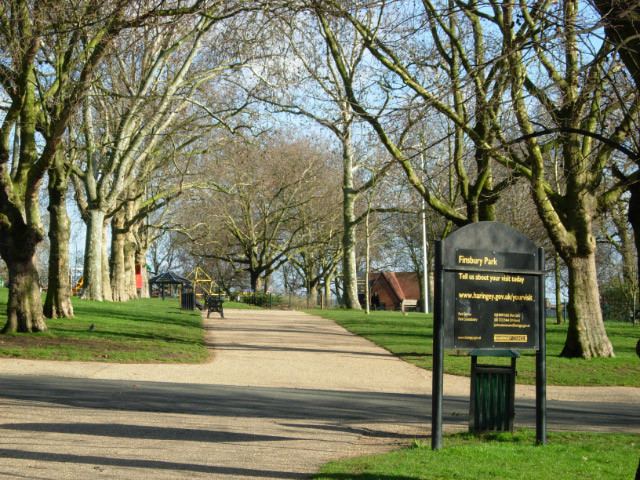Designer Frederick Manable Area 46 ha | Opened 1869 Designation Grade II Listed | |
 | ||
Hours Open today · 6:15AM–7:15PMSunday6:15AM–7:15PMMonday6:15AM–8PMTuesday6:15AM–8PMWednesday6:15AM–8PMThursday6:15AM–7:15PMFriday6:15AM–8PMSaturday6:15AM–7:15PM Similar Methodist Central Hall - Wes, Barbican Estate, Greenwich Park, Earls Court Exhibition Centre, Wireless Festival | ||
The pengest munch ep 2 eden s cottage finsbury park
Finsbury Park is a public park in the ward of the London neighbourhood of Harringay. It is in the area formerly covered by the historic parish of Hornsey, succeeded by the Municipal Borough of Hornsey. It was one of the first of the great London parks laid out in the Victorian era. The park borders the districts of Finsbury Park, Harringay, Stroud Green, and Manor House.
Contents
- The pengest munch ep 2 eden s cottage finsbury park
- Facilities
- Before the park
- Creation of the park
- During the wars
- Regeneration
- Live music in Finsbury Park
- In popular culture
- References
Facilities
The park has a mix of open ground, formal gardens, avenues of mature trees and an arboretum. There is also a lake, a children's play area, a cafe and an art exhibition space. Sports facilities in the park include football pitches, a bowling green, an athletics stadium, and tennis and basketball courts. Unusually for London, the park hosts two facilities for "American" sports: an American football field, home to the London Blitz, and diamonds for softball and baseball, home to the London Mets.
Parkland Walk, a linear park, provides a route that links the park with Crouch Hill Park, Crouch End, and Highgate tube station.
Before the park
The park was landscaped on the northeastern extremity of what was originally a woodland area in the Manor or Prebend of Brownswood. It was part of a large expanse of woodland called Hornsey Wood that was cut further and further back for use as grazing land during the Middle Ages. In the mid-18th century a tea room had opened on the knoll of land on which Finsbury Park is situated. Londoners would travel north to escape the smoke of the capital and enjoy the last remains of the old Hornsey Wood. Around 1800 the tea rooms were developed into a larger building which became known as the Hornsey Wood House/Tavern. A lake was also built on the top of the knoll with water pumped up from the nearby New River. There was boating, a shooting and archery range, and probably cock fighting and other blood sports. The Hornsey Wood Tavern was destroyed in the process of making the area into a park, but the lake was enlarged. Once the park had opened, a pub across the road from its eastern entrance along Seven Sisters Road called itself the Hornsey Wood Tavern after the original. This pub was later renamed the Alexandra Dining Room and closed for business in April 2007. It was subsequently demolished.
Creation of the park
During the early part of the second quarter of the 19th century, following developments in Paris, Londoners began to demand the creation of open spaces as an antidote to the ever-increasing urbanisation of London. In 1841 the people of Finsbury in the City of London petitioned for a park to alleviate conditions of the poor. The present-day site of Finsbury Park was one of four suggestions for the location of a park.
Originally to be named Albert Park, the first plans were drawn up in 1850. Renamed Finsbury Park, plans for the park's creation were ratified by an Act of Parliament in 1857. Despite some local opposition, the park was opened in 1869.
During the wars
During the First World War the park was known as a location for pacifist meetings.
During the Second World War, the park was used as military training grounds and also hosted anti-aircraft guns.
Regeneration
Through the late 20th Century the park began to fall into a state of disrepair with most of the original features gone by the 1980s. This decline was worsened in 1986 when the then owner, Greater London Council was wound up and ownership was passed on Haringey Council but without sufficient funding or a statutory obligation for the park's upkeep.
A £5 million Heritage Lottery Fund Award, made in 2003, enabled significant renovations including cleaning the lake, building a new cafe and children's playground and resurfacing and repairing the tennis courts. The park now contains tennis courts, a running track, a softball field and many open spaces for various leisure activities.
Live music in Finsbury Park
The park has hosted several live music performances and music festivals.
